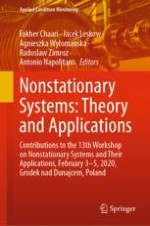2022 | Buch
Nonstationary Systems: Theory and Applications
Contributions to the 13th Workshop on Nonstationary Systems and Their Applications, February 3-5, 2020, Grodek nad Dunajcem, Poland
herausgegeben von: Prof. Fakher Chaari, Jacek Leskow, Agnieszka Wylomanska, Radoslaw Zimroz, Antonio Napolitano
Verlag: Springer International Publishing
Buchreihe : Applied Condition Monitoring
